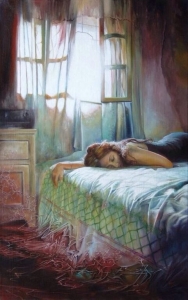As an utterance occurs in the process of communication, it seems logical to divide it, first, into sentences, and then into words. It is universally agreed that the number of words doesn’t characterize a sentence: it may be long or contain one word only, so that the number of words in a sentence is one, or more than one.
N(wds)≥ 1
Similarly, a text may also be long, or contain one sentence, so
N(sts)≥ 1
Thus, a text has its lower limit, one sentence, and this, in its turn, may contain only one word.
Therefore the sign «Stop» is a text.
The poem by Tom Raworth, which contains nothing, but the title «poem» (with a small «p»)
In Van Dijk’s opinion a text may consist of n sentences (where n≥1), but will not be described in terms of underlying sentence structure, not as a linearly ordered set of sentences, but as a coherent whole.
The well-known English scholar M. Halliday, emphasizing the irrelevance of length for the definition of a text, pointed out that texts may include the Japanese haiku which is a poem of 17 syllables only, or a Homeric epic.
Although length cannot distinguish texts from sentences, or even words, it may serve as an important distinctive feature in genres. Thus, literature and folklore possess a great wealth of aphoristic sayings, highly structured and forming complete messages characterized by shortness, compactness.
A proverb is a short popular saying that with bold imagery expresses effectively some commonplace truth or usual thought. (Manners make the man)
World literature knows many forms of verse specifically limited in length. The ancient monostich contained only one line. Also distich-lines form is still used. Wystan Hugh Auden adapted this form in his ironical «marginalia», notes in the margin of a book, manuscript, or letter.
Quatrains or rubais – 4-line poems.
Five lines also have their peculiar form – the limerick, a sort of fun-making jingle. It is a form of comic verse consisting of five anapaestic lines of which the first, second, and fifth have three metrical feet and rhyme together. Coming originally from the folklore, limericks were especially popularized by Ed. Lear in his Book of Nonsense.
A sonnet is a verse form of Italian origin consisting of 14 lines in iambic pentameter with rhymes arranged according to a fixed scheme, usually divided into octave and sestet, or in the English form, into three quatrains and a couplet. It expresses a single complete thought or feeling.
Thus, though the length of the text is irrelevant for its definition, it may serve as an important distinctive feature in genres and help to differentiate a limerick from a proverb, or a sonnet from a quatrain.
Another problem that arises next is that of constituent elements and size. Should a text be divided into words or sentences necessary for a message to be considered a text?
As an utterance occurs in the process of communication it seems logical to divide it first into sentences and then into words. It is universally agreed that the number of words does not characterise a sentence." it may be long or contain one word only, so that the number of words in a sentence is > = 1. Similarly a text may also be long or contain one sentence only so it consists of n sentences where n > = 1.
Thus a text has its lower limit one sentence and this in its turn may contain only one word. Therefore the sign "Stop!" is a text. One might mention as a curiosity a poem by Tom Raworth (1970) containing nothing but the title "poem" (with a small p).
The opinion that the lower limit of the text is two words is quite illogical - the number of words is entirely beside the point.
It may be of interest to note that although length cannot distinguish texts from sentences or even words, as we have seen, it may serve as an important distinctive feature in genres.
Thus, literature and folklore possess a great wealth of aphoristic sayings, highly structured and forming complete messages characterized by shortness, compactness. E.g. He that is warm thinks all so (a proverb)
World literature knows many forms of verse specifically limited in length. The ancient monostich as the name implies, contained only one line. The distich-lines form is still used.
Five lines also have their peculiar poetic form - the limerick, a sort of fun-making jingle. Coming originally from the folklore limericks were popularized by Ed.Lear in his “Book of Nonsense”.
A sonnet is a poem consisting of 14 lines, expressing a single complete thought or feeling usually in iambic pentameter.

